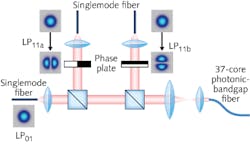HIGH-DATA-RATE COMMUNICATIONS: Broadband mode-division multiplexing demoed in hollow-core fiber
Developers of hollow-core fibers announced two important firsts in a March 21, 2013 postdeadline paper at this year’s Optical Fiber Communication Conference and Exhibition and National Fiber Optic Engineers Conference (OFC/NFOEC 2013). Yongmin Jung of the University of Southampton (Southampton, England) reported successfully scaling up the hollow core to a record size while maintaining low loss and high bandwidth, then using that fiber for mode-division multiplexing—the first in a hollow-core fiber. Those steps are milestones toward achieving high-performance transmission through hollow-core photonic-bandgap fibers.
Hollow-core fibers attracted early attention because their air cores offer the potential for very low nonlinearity and attenuation. They also could reduce signal transmission time, or latency, below the minimum possible in glass-core fibers. However, surface modes generated by the interaction between light guided in the core and the surrounding cladding initially limited fiber bandwidth and caused other problems. To reduce those interactions, developers have found ways to increase core size by removing more central unit cells before fusing them together and drawing them down into a single fiber. These new fibers are now paying dividends in higher-performance transmission.
1.48 Tbit/s over hollow-core fiber
David Richardson’s group at Southampton has drawn 19-cell, hollow-core fiber with loss of 3.5 dB/km and a 3 dB bandwidth of 160 nm in the erbium-fiber C band. They used that fiber to transmit 40 Gbit/s on 37 wavelength-division multiplexed (WDM) channels—a total of 1.48 Tbit/s—through 260 m of the hollow-core fiber. The signals took only 870 ns to pass through the hollow-core fiber, compared to 1270 ns through a conventional glass-core fiber.
“This represents the first experimental demonstration of fiber-based WDM data transmission at close to (99.7%) the speed of light in vacuum,” Francesco Poletti and colleagues from Southampton wrote in a paper posted online at Nature Photonics three days after the OFC postdeadline session.1 Achieving such speeds in practical telecommunication systems could reduce latency for applications ranging from high-frequency automated stock trading to cloud computing.
The OFC paper addresses two other issues: loss and transmission capacity. Aiming for lower loss, the Southampton researchers sought to reduce scattering by further expanding the core to 37 cells. Fabrication tolerances are needed to make hollow fibers with larger cores, and they can guide more modes spaced more tightly than smaller-core fibers. But at OFC, Jung said that multiple-input multiple-output (MIMO) techniques could put the extra modes to work as independent transmission channels for mode-division multiplexing, and described experiments that achieved record transmission capacity for a hollow-core fiber.
They made the hollow-core fiber by omitting the central 37 capillary tubes in a structure similar to that used for the 19-cell fiber. A cladding of parallel hollow tubes with a pitch of 4.4 μm and 97% of the space empty surrounding the 37 μm core provides a bandgap about 300 nm wide. They found that their fiber transmitted only two groups of surface modes, one on each side of the C band, leaving a low-loss band 85 nm wide.
Increasing the core size helped them reduce fiber loss to 3.3 dB/km. In theory, that’s large enough to support up to 80 core modes, but they measured only 16 modes, belonging to five groups—fewer than they had recorded in the 19-cell hollow-core fiber. Modes above LP02 had high propagation losses, probably because they coupled to high-loss cladding modes. The attenuation measured at 1550 nm was 3.3 dB/km for the LP01 mode and 7.4 dB/km for the LP11a and LP11b modes. The authors suspect the LP11 modes overlapped more with the airglass interface.2
Modal-division multiplexing
The fiber’s modal properties encouraged the group to test a modal-division multiplexing technique demonstrated last year in a few-mode solid-core fiber by Vincent Sleiffer of the Eindhoven University of Technology (Eindhoven, The Netherlands).3 They used 96 WDM channels spaced at 50 GHz intervals between 1528 and 1567 nm and modulated with 256 Gbit/s dual-polarization, 16-level quadrature amplitude modulation, producing a total date rate of 24.6 Tbit/s. To test modal-division multiplexing, they divided the signal into three equal portions, added time delays, and used them to drive the LP01, LP11a, and LP11b modes of a 310 m length of the hollow-core fiber. After demultiplexing, they found that all channels had error rates below the maximum tolerable with forward-error correction, “providing compelling evidence of excellent fiber modal characteristics,” says Jung.
The total data rate of 73.7 Tbit/s corresponds to an impressive spectral efficiency of 12 bit/s/Hz, an encouraging sign for modal-division multiplexing. Major practical barriers remain in limiting crosstalk between modes during transmission, multiplexing, and demultiplexing. The lowest attenuation remains 1.7 dB/km, measured in 2004—more than 10 times that of standard singlemode fiber.4
REFERENCES
1. F. Poletti et al., Nat. Photon., doi:10.1038/NPHOTON.2013.45 (March 24, 2013).
2. Y. Jung, “First demonstration of a broadband 37-cell hollow-core photonic bandgap fiber and its application to high capacity mode division multiplexing,” OFC/NFOEC 2013, paper PDP5A.3.
3. V. A. J. M. Sleiffer et al., Opt. Exp., 20, B428 (2012).
4. B. J. Mangan et al., OFC 2004, postdeadline paper PDP 24.

Jeff Hecht | Contributing Editor
Jeff Hecht is a regular contributing editor to Laser Focus World and has been covering the laser industry for 35 years. A prolific book author, Jeff's published works include “Understanding Fiber Optics,” “Understanding Lasers,” “The Laser Guidebook,” and “Beam Weapons: The Next Arms Race.” He also has written books on the histories of lasers and fiber optics, including “City of Light: The Story of Fiber Optics,” and “Beam: The Race to Make the Laser.” Find out more at jeffhecht.com.
